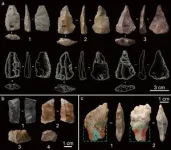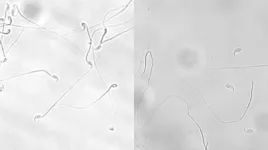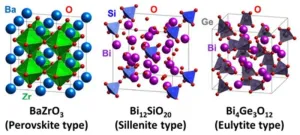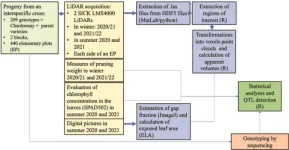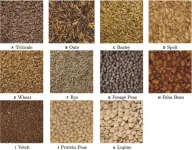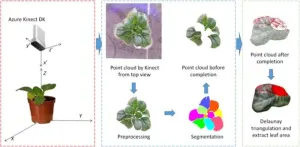(Press-News.org)
A team of researchers from China, Australia, France, Spain, and Germany has revealed advanced material culture in East Asia by 45,000 years ago.
The new study was published in Nature Ecology & Evolution on Jan. 18.
The researchers examined a previously excavated archaeological collection from the Shiyu site, located in Shanxi Province.
"Our new study identified an Initial Upper Palaeolithic archaeological assemblage from the Shiyu site of North China dating to 45,000 years ago that includes blade technology, tanged and hafted projectile points, long-distance obsidian transfer, and the use of a perforated graphite disk," said associate Prof. YANG Shixia, first and corresponding author of the study and a researcher at the Institute of Vertebrate Paleontology and Paleoanthropology (IVPP) of the Chinese Academy of Sciences (CAS).
This discovery uncovered a treasure trove of cultural and technological innovations. Together with the recovery of a now lost human cranial bone, it sheds light on the ancient migration of Homo sapiens into East Asia around 45,000 years ago.
The researchers dated three animal bone samples recovered during the original 1963 excavation, and these were shown to be humanly modified as indicated by cut marks. Radiocarbon methods precisely dated the main cultural layer of Shiyu to between 45,800 and 43,200 years ago.
Integrated scientific studies on the archaeological findings at Shiyu revealed an advanced material culture dating to 45,000 years ago. This includes Levallois points, tanged and hafted projectile points with evidence of impact fractures, long-distance transfers of obsidian from sources hundreds of kilometers away, a perforated graphite disk, and well-shaped bone points.
The results of the taphonomic analysis of the mammal fossils, combined with use-wear analysis of the stone tools, indicated that the Shiyu inhabitants were "horse hunters" equipped with tanged and hafted projectile points, thus having the ability to hunt and selectively cull adult equids.
Shiyu provides us with an opportunity to look into the life of the skillful hunters from northern China 45,000 years ago. The people inhabiting the region had a remarkably advanced toolkit, with a range of innovative tools from the Upper Palaeolithic, including end-scrapers, awls, and tools of former times, including Middle Palaeolithic Levallois points, various tanged tools, denticulates, and borers.
The unique set of stone tool artefacts, in combination with the shaped graphite disc and bone tools, shows that early peoples had a rich culture. The long-distance transport of obsidian from sources hundreds of kilometers away also indicates advanced and long-distance resource procurement strategies and migration abilities.
Shiyu reflects a process of cultural creolization—through contact between societies and relocated peoples—whereby inherited traits blended with novel innovations, thus complicating the traditional understanding of Homo sapiens' global expansion.
END
Throughout the brain’s cortex, neurons are arranged in six distinctive layers, which can be readily seen with a microscope. A team of MIT neuroscientists has now found that these layers also show distinct patterns of electrical activity, which are consistent over many brain regions and across several animal species, including humans.
The researchers found that in the topmost layers, neuron activity is dominated by rapid oscillations known as gamma waves. In the deeper layers, slower oscillations called alpha and beta waves ...
200 US communities will fail to transition to 100% renewable energy by 2050 despite their pledges to do so, according to a new study published in IOP Publishing’s journal Environmental Research: Infrastructure and Sustainability.
The study shows that by 2050 gas will firmly remain the primary source of energy in the US given that the current infrastructure plans for implementing renewable energy cannot provide sufficient energy output. Recent projections suggest that renewable energy generation will need to triple to meet even a 45% share of energy production. The results indicate that in many instances renewable energy ...
The European Society of Endocrinology (ESE) is pleased to announce that the new Editor-in-Chief of our flagship journal, the European Journal of Endocrinology (EJE), is Professor Felix Beuschlein, M.D. He will assume his post in May 2024 when the current Editor in Chief, Professor Wiebke Arlt, steps down.
Professor Philippe Chanson, Chair of ESE’s Publications and Communications Committee said, “I am delighted that Felix will be the next Editor in Chief of ESE’s flagship journal and will continue to build on the strong foundations laid by his predecessors. Felix’s internationally ...
Mice lacking a certain gene are unable to produce offspring because their sperm lack the connection between the tail and the head. A new thesis from the University of Gothenburg indicates a probable cause of male infertility.
Researchers at the University of Gothenburg have identified a new protein, dubbed by them as “MC2”, that plays a crucial part in the formation of swimmable sperm in mice. This protein is needed to create a functional connection between the head and the tail of the sperm.
“The connection is located in the ‘neck’ of the sperm head and facilitates coordinated movement and function ...
(WASHINGTON, DC) 18 JANUARY 2024 — Bottom trawling is a previously unaccounted for source of atmospheric carbon emissions, scientists reveal in a study published today. As the world scrambles to slash emissions caused by fossil fuels, deforestation and other sources, the study finds bottom trawling — the act of dragging a heavy fishing net across the ocean floor and resuspending some of the carbon in the seafloor sediment — to be a significant source of atmospheric carbon pollution. A previous study found that part of that disturbed ...
Osaka, Japan – At the heart of global internet connectivity, optical communications form an indispensable foundation. Key to this foundation are optical isolators, created by combining multiple components. The result is a complex structure that transmits light in only one direction, to prevent damage to lasers and minimize noise by avoiding the reversal of light. However, some magnetic materials have an optical diode effect – an unconventional nonreciprocal absorption of light manifested by the material itself. This effect leads to a change in transmittance depending ...
Fukuoka, Japan – Researchers at Kyushu University, in collaboration with Osaka University and the Fine Ceramics Center, have developed a framework that uses machine learning to speed up the discovery of materials for green energy technology. Using the new approach, the researchers identified and successfully synthesized two new candidate materials for use in solid oxide fuel cells – devices that can generate energy using fuels like hydrogen, which don’t emit carbon dioxide. Their findings, which were reported in the journal, ...
In response to the pressing need to reduce pesticide usage and adapt grapevine varieties to climate change, there's an unprecedented effort to phenotype new genotypes using high-throughput methods. Teams globally are developing advanced systems, employing technologies like multispectral cameras and LiDAR, to assess growth traits, photosynthetic capability, and other architectural parameters. However, traditional methods remain time-consuming and less efficient for large-scale studies. The current research gap lies in effectively employing LiDAR technology ...
Cultivating seed mixtures for local pastures is an age-old method to produce cost-effective and balanced animal feed, enhancing agricultural autonomy and environmental friendliness in line with evolving European regulations and organic consumer demands. Despite its benefits, farmers face adoption challenges due to the asynchronous ripening of cereals and legumes and the difficulty in assessing the nutritional value of heterogeneous seeds. Current practices rely on informal, empirical methods, and a proposed solution is to develop a mobile app or online service, similar to Pl@ntNet, for automated nutritional evaluation of seed mixtures, ...
The 3-dimensional point cloud technology revolutionizes non-invasive measurement of plant phenotypic parameters, offering vital data for agriculture and research. Current research focuses on overcoming the limitations of 2.5D imaging and occlusions. Methods such as structure from motion, multi-view stereo, and advanced active 3D reconstruction techniques are being explored for this purpose. However, issues persist with incomplete data acquisition and the inaccuracy of phenotypic parameter extraction due ...

